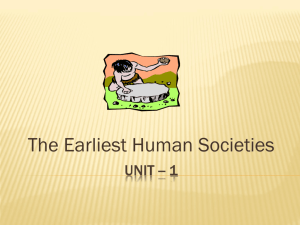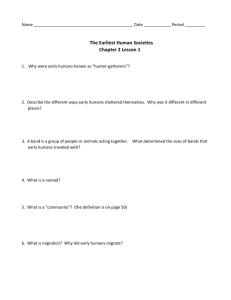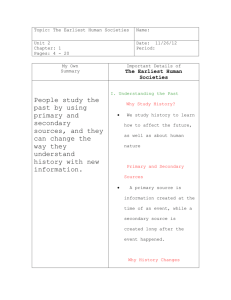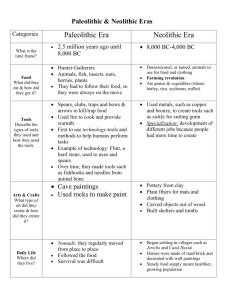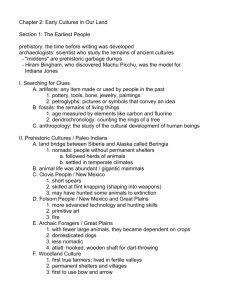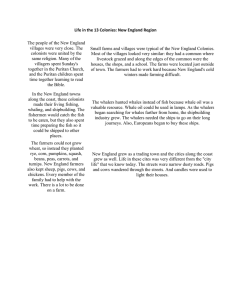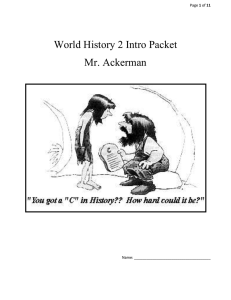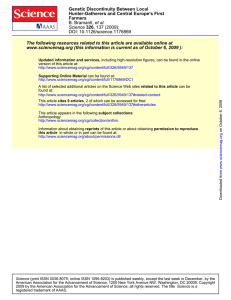The Earliest Human Societies
advertisement
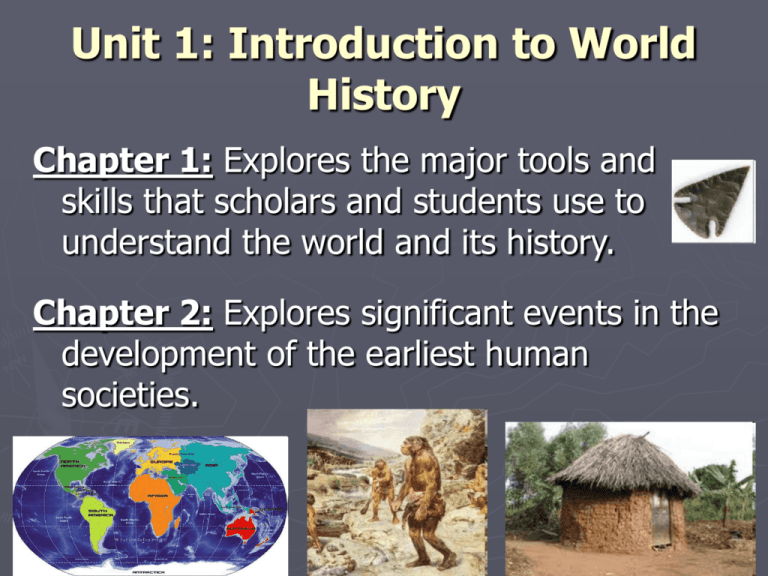
Unit 1: Introduction to World History Chapter 1: Explores the major tools and skills that scholars and students use to understand the world and its history. Chapter 2: Explores significant events in the development of the earliest human societies. The Earliest Human Societies Chapter 2 Hunters and Gatherers: Chapter 2 – Lesson 1 Hunter – gatherer: human beings who hunt animals and gather plants for food. Hunter-gatherers would move to a new location when they no longer had enough to eat. Caves and Rock Shelters Hunter-gatherers depended on the natural environment for shelter. Examples: caves and rock shelters If the hunter-gatherer lived in the desert they made houses out of branches, plant fibers and animal skin. Nomads Migrate Nomads: hunter-gatherers who move from place to place, never staying in one area for long. Migration: a movement from one region or country to settle in another. By around 15,000 B.C. hunter-gatherers had migrated throughout much of the world. Use of Fire About 500,000 years ago, early humans learned to make and control fire. Uses: Heat, Light, Cooking Food **A good fire also offered protection from animals and heat to harden tools. The Development of Technology 2 million years ago, people made stone tools for cutting. In time, more advanced tools were made. Examples: Bow and arrows, spearheads, and metal tools *Technology (these new tools) gave humans more control over their environment. Language Human language probably developed as a result of the need for people to work together. Examples: to outsmart, trap and kill animals for food Religion Religion: the worship of God, gods or spirits. Some archaeologists believe that early cave paintings of animals were made to honor the spirits of animals killed for food. Prehistoric Art Prehistoric Art gives us an idea of the daily life of early humans and their beliefs. Cave Paintings thousands of years old show lively images of bulls, stallions, and bison. Learning to Farm and Raise Animals Chapter 2, Lesson 2 By around 8,000 B.C., early humans learned to change the environment by growing plants and raising animals. Climate Changes Global warming resulted in the retreat of the Ice Age glaciers. Due to this, early humans could move into new areas, growing seasons became longer, humans and animals had more grain to eat. The Agricultural Revolution Around 8,000 B.C. people got the idea of agriculture or the planting of seeds to raise crops. Agricultural Revolution is the name given to the change from food gathering to food raising. New tools were used: ► Hoes to loosen the soil ► Sticks to dig holes ► Sickles to harvest grain Settlement Begins Fertile soil produced bigger and better crops. This attracted farmers to stay in one area and develop permanent settlements. Several thousand people lived in villages. Shelters were made of: ► mud ► brick ► logs ► hides Farming Develops in Many Places African farmers along the Nile were among the first to use irrigation. This allowed plants to be watered by building dikes and canals. The First Communities Chapter 2, Lesson 3 As agricultural techniques improved, farmers sometimes produced surpluses – more than what they needed to survive. Examples: ► Farmers might grow more grain than their families or villages could use. ► Sheep raisers may have had surplus wool. *Surpluses of food and other materials in good seasons helped villages survive bad season. Specialized Jobs A specialization is a skill in one kind of work. In a village you would find: Potter: made objects for carrying water or food Weavers: created cloth from spun cotton, wool, and flax (a plant from which linen is made) Holy People / Shamans: interpreted natural events such as rain or fire, explained the meaning of good and bad harvest and were healers. Weaver Pottery Shaman Simple Villages Grow More Complex Trade, specialized jobs and government all began to form. ► Social classes: a group of people with similar customs, backgrounds, trainings, and income began to develop Example: - farmers - Potters, weavers, holy men Catal Huyuk had a population of about 5,000 people. ► Agriculture developed fairly early. ► Bones of water birds found in Catal Huyuk suggest villages were built in marshy areas. ► Houses had floor plans ► Some buildings served as shrines, where religious ceremonies took place Catal Huyuk- Turkey Complex Village
